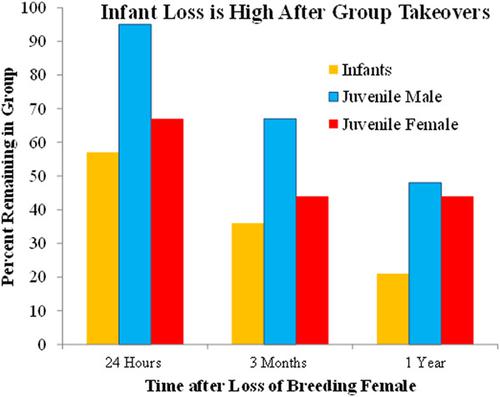当前位置:
X-MOL 学术
›
Am. J. Primatol.
›
论文详情
Our official English website, www.x-mol.net, welcomes your
feedback! (Note: you will need to create a separate account there.)
Factors influencing the survival of wild cotton-top tamarin (Saguinus oedipus) infants
American Journal of Primatology ( IF 2.0 ) Pub Date : 2021-04-26 , DOI: 10.1002/ajp.23262 Anne Savage 1 , Charles T Snowdon 2 , Luis Soto 3 , Felix Medina 3 , German Emeris 3 , Rosamira Guillen 3
American Journal of Primatology ( IF 2.0 ) Pub Date : 2021-04-26 , DOI: 10.1002/ajp.23262 Anne Savage 1 , Charles T Snowdon 2 , Luis Soto 3 , Felix Medina 3 , German Emeris 3 , Rosamira Guillen 3
Affiliation

|
Studies of cooperative breeding species have suggested that helpers are needed for infant survival and that helpers gain skills to successfully raise their own offspring. Studies of callitrichids in managed care and early field studies suggested that group size correlated with infant survival and that helpers needed to learn parental skills to be successful breeders. We present infant survival data from a 20-year field study of cotton-top tamarins (Saguinus oedipus) in Colombia involving 126 litters born to 41 females. There was no difference in the survival of male and female offspring to 6 months of age. However, litter size impacted survival, with triplet litters having lower survival and male triplets having lower survival than females. Loss of infants was highest in the first week of life and, of the animals remaining in the group at 6 months of age, 90% of them survived to 1 year. The mean length of time in the natal group was 2.3 years but some young migrated to other groups after 4 months of age. Group size and number of male helpers (>1 year) was not related to infant survival. However, groups with only one male had fewer surviving infants. Primiparous females had lower infant survival, but previous infant care experience by mothers as helpers had no effect on survival. A major cause of infant loss was group disruption due to deaths/evictions/loss of the reproductively active animals, or immigration of pregnant females. Thus, factors that cause a change in the stability of the reproductively active animals can disrupt group cohesion. Capture of individuals for the illegal pet trade, as well as habitat fragmentation, may increase competition between groups for access to territories and breeding opportunities. This may have long-term impacts to infant survival in this critically endangered species.
中文翻译:

影响野生棉顶狨(Saguinus oedipus)幼崽存活的因素
对合作育种物种的研究表明,婴儿的生存需要帮助者,帮助者获得成功养育后代的技能。在管理式护理和早期实地研究中对 callitrichids 的研究表明,群体规模与婴儿存活率相关,并且帮助者需要学习父母的技能才能成为成功的饲养员。我们提供了一项 20 年棉顶狨( Saguinus oedipus)实地研究的婴儿存活数据) 在哥伦比亚,涉及 41 名雌性所生的 126 窝。雄性和雌性后代到 6 个月大时的存活率没有差异。然而,窝产仔数影响存活率,三胞胎的存活率较低,雄性三胞胎的存活率低于雌性。婴儿在出生后第一周的损失最高,在 6 个月大时留在该组的动物中,90% 的动物存活到 1 岁。出生组的平均时间长度为 2.3 年,但一些年轻人在 4 个月大后迁移到其他组。男性助手的群体规模和数量(> 1 岁)与婴儿存活率无关。然而,只有一名男性的组幸存的婴儿较少。初产女性的婴儿存活率较低,但母亲之前作为帮手的婴儿护理经验对存活率没有影响。婴儿丢失的一个主要原因是由于繁殖活跃的动物的死亡/驱逐/丢失或怀孕女性的移民而导致的群体中断。因此,导致繁殖活跃动物稳定性发生变化的因素会破坏群体凝聚力。因非法宠物贸易而捕获个体以及栖息地破碎化,可能会加剧群体之间对领地和繁殖机会的竞争。这可能会对这种极度濒危物种的婴儿生存产生长期影响。以及栖息地的破碎化,可能会加剧群体之间对领地和繁殖机会的竞争。这可能会对这种极度濒危物种的婴儿生存产生长期影响。以及栖息地的破碎化,可能会加剧群体之间对领地和繁殖机会的竞争。这可能会对这种极度濒危物种的婴儿生存产生长期影响。
更新日期:2021-06-24
中文翻译:

影响野生棉顶狨(Saguinus oedipus)幼崽存活的因素
对合作育种物种的研究表明,婴儿的生存需要帮助者,帮助者获得成功养育后代的技能。在管理式护理和早期实地研究中对 callitrichids 的研究表明,群体规模与婴儿存活率相关,并且帮助者需要学习父母的技能才能成为成功的饲养员。我们提供了一项 20 年棉顶狨( Saguinus oedipus)实地研究的婴儿存活数据) 在哥伦比亚,涉及 41 名雌性所生的 126 窝。雄性和雌性后代到 6 个月大时的存活率没有差异。然而,窝产仔数影响存活率,三胞胎的存活率较低,雄性三胞胎的存活率低于雌性。婴儿在出生后第一周的损失最高,在 6 个月大时留在该组的动物中,90% 的动物存活到 1 岁。出生组的平均时间长度为 2.3 年,但一些年轻人在 4 个月大后迁移到其他组。男性助手的群体规模和数量(> 1 岁)与婴儿存活率无关。然而,只有一名男性的组幸存的婴儿较少。初产女性的婴儿存活率较低,但母亲之前作为帮手的婴儿护理经验对存活率没有影响。婴儿丢失的一个主要原因是由于繁殖活跃的动物的死亡/驱逐/丢失或怀孕女性的移民而导致的群体中断。因此,导致繁殖活跃动物稳定性发生变化的因素会破坏群体凝聚力。因非法宠物贸易而捕获个体以及栖息地破碎化,可能会加剧群体之间对领地和繁殖机会的竞争。这可能会对这种极度濒危物种的婴儿生存产生长期影响。以及栖息地的破碎化,可能会加剧群体之间对领地和繁殖机会的竞争。这可能会对这种极度濒危物种的婴儿生存产生长期影响。以及栖息地的破碎化,可能会加剧群体之间对领地和繁殖机会的竞争。这可能会对这种极度濒危物种的婴儿生存产生长期影响。











































 京公网安备 11010802027423号
京公网安备 11010802027423号